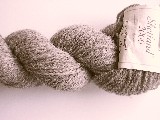

Yarn Profile: Shetland 2000 First Impressions
Pure Shetland sheep provide so many color variations that, at one point, Shetland wool brokers exported more than 30 colors of undyed yarn alone. Today, the demand for dyed colors has forced many Shetland wool producers to breed other sheep that produce easily dyed white fiber instead. This yarn is the result of a collaboration between Yarns International and Jamieson and Smith Wool Brokers of Lerwick, Shetland. It is pure, undyed Shetland wool grown in the Shetland Islands. It is currently available in five colors: Shetland White (cream), Mooskit (grayish brown), Shaela (steely gray), Moorit (somewhere between fawn and dark reddish brown), and Shetland Black (brownish black). Knitting Up
This helped make knitting a breeze. The yarn didn't snag, and its firmness allowed me to knit easily by touch alone. The resulting swatches were fine, thin, and eager to become part of something useful. Blocking / Washing
My swatches bloomed and softened with wash, but I was barely able to detect a change in gauge. There's no need to worry about your colors bleeding or fading, since they're in the wool itself. You'll want to take the time to block your garments flat. Even while wet, the ends of my swatches wanted to curl up. Wearing
Although Shetland 2000 is softer than many dyed Shetland yarns, it still has a relatively high itch rating. On the flip side, it's a slender but strong yarn that will keep you warm for years. Conclusion
I only hope this collaboration will continue and that we'll see the reintroduction of more natural colors into the Shetland wool market. |
Yarn name
Shetland 2000
Manufacturer
Yarns International
Fiber content
100% Shetland wool
Gauge
32 to 35 sts per 4 in/10cm square on US 3-4 (3.25-3.5 mm) needles
Average retail
price
$7.95 / skein
Where to Buy Online
Yarns International
Weight/Yardage per Skein
50g. / 190 yards
Country of Origin
Shetland Islands, U.K.
Manufacturer's
suggested wash method
None given
Review date
11/21/2001 |
Copyright © 2000-2016 Clara H. Parkes
All rights reserved. Permission to reproduce is required.
All rights reserved. Permission to reproduce is required.
